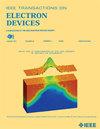Sigmoid Probabilistic Bits Using SiOₓ Threshold Switching Devices for Probabilistic Computing
IF 2.9
2区 工程技术
Q2 ENGINEERING, ELECTRICAL & ELECTRONIC
引用次数: 0
Abstract
We present probabilistic bits (p-bits) implemented using a simple and fabrication-friendly Ti/SiOx/Ti stack for probabilistic computing. Sputter-deposited thin SiOx films (<10>使用SiO的s型概率比特ₓ用于概率计算的阈值开关器件
我们提出了概率位(p位),使用简单且易于制造的Ti/SiOx/Ti堆栈实现概率计算。溅射沉积的SiOx薄膜(${V} _{\text {out}}$)响应给定的输入电压(${V} _{\text {in}}$)脉冲而振荡。当引入化学反应性Ti清除层时,观察到不均匀的TS特性,导致开关电压(或电阻)变化和意外的振荡失效。因此,${V} _{\mathbf {out}}$振荡开始以随机尖峰的形式被检测到,模拟将数据表示为“1”(P1)的概率。值得注意的是,我们证明了当SiOx层夹在两个接口的Ti清除剂之间时,${P} _{{1}}$的值可以控制在0和1之间,与${V} _{\mathbf {in}}$成反比关系。这条由Ti/SiOx/Ti P位导出的sigmoid ${P} _{{1}}$曲线在执行模拟退火(SA)算法中起着至关重要的作用。通过MATLAB仿真验证了这种能力,并将该方法应用于通过识别最优解来解决车辆路线问题(vrp)。
本文章由计算机程序翻译,如有差异,请以英文原文为准。
求助全文
约1分钟内获得全文
求助全文
来源期刊

IEEE Transactions on Electron Devices
工程技术-工程:电子与电气
CiteScore
5.80
自引率
16.10%
发文量
937
审稿时长
3.8 months
期刊介绍:
IEEE Transactions on Electron Devices publishes original and significant contributions relating to the theory, modeling, design, performance and reliability of electron and ion integrated circuit devices and interconnects, involving insulators, metals, organic materials, micro-plasmas, semiconductors, quantum-effect structures, vacuum devices, and emerging materials with applications in bioelectronics, biomedical electronics, computation, communications, displays, microelectromechanics, imaging, micro-actuators, nanoelectronics, optoelectronics, photovoltaics, power ICs and micro-sensors. Tutorial and review papers on these subjects are also published and occasional special issues appear to present a collection of papers which treat particular areas in more depth and breadth.
 求助内容:
求助内容: 应助结果提醒方式:
应助结果提醒方式:


